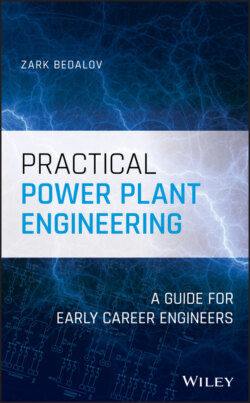Читать книгу Practical Power Plant Engineering - Zark Bedalov - Страница 67
2.7.10 Bus Tie Breaker Switching 2.7.10.1 Incoming Transformer Failure
ОглавлениеAccording to the overall key one‐line diagram, a part of which we repeat here in Figure 2.11, the incoming transformer T11 feeds Bus A, while the T12 feeds the Bus B of the main 13.8 kV switchgear. The switchgear bus tie breaker is held open during the normal plant operation and its operating control switch on its front panel is held on Loc/Rem position.
The incoming breaker transfer switching can be arranged by the plant control system (automatic) or hard wire logic (manual) on the switchgear. The bus tie breaker is not allowed to be closed while both incomers are closed. Once either incoming circuit breaker opens, the tie breaker closes immediately behind, if its control switch is also placed on Loc/Rem. Generally, all the main breakers should have their switches on placed on Loc/Rem position.
Figure 2.11 Switchgear breaker interlocks.
In case of a failure of one of the transformers, the faulty transformer (Assume: T12 on B bus) will be isolated by being tripped automatically or manually (locally). Once the incoming breaker for the transformer T12 opens, a signal is sent to fully isolate T12 by tripping its HV breaker. This will be followed by closing the 13.8 kV bus tie breaker.
Please note, all the B buses from 13.8 kV down to 480 V are temporarily shut down following the isolation of the faulty T12 transformer. When the tie breaker closes, the healthy transformer (T11) now feeds both Buses A and B. The control system now starts restoring the power (incoming and tie breakers) sequentially from the top bus to the lowest bus in that order to operate the plant on the single transformer. The whole process of power restoration is completed within several seconds.
This automatic switching process explained above is more applicable to the power plants, which may have three or four buses operated from 13.8 kV down to 480 V. The industrial plants have fewer plant bus levels, and the switching following a transformer failure may be manual.
The actual switching is arranged on the “Break before Make” principle. This is also called a “Dead Transfer.” Therefore, the two incomers + tie breakers operate on 2 out of 3 closed principle. However, since we are also planning to connect the standby DG to the Bus B in case of a total outage, the operating logic must accommodate an operating condition of 2 out of 4 breakers closed. Should there be a total power outage, both switchgear incomer breakers are opened, a signal is sent to the standby DG to start and close onto the 13.8 kV bus. That done, the tie breaker closes next (2 out of 4 conditions) and the essential power restoration commences across the whole 13.8 kV bus and the plant.
The breaker operating and closing coils as well as the protection and trip circuits operate on 125 Vdc circuits fed from the station battery. By having the DC system available, the main breakers can be operated during a total plant outage.
The plant restoration following a total blackout and DG operation follows by the appearance of voltage on the HV side of the main transformers. HV breakers are closed and a proper safe moment is awaited to initiate the restoration of the overall power distribution system.
Switching and restoring the service when the faulty transformer is brought back follows a similar procedure in reverse order. The incomer B is switched ON, on its HV side. This initiates the tie breaker T to open first, followed by closing the incomer breaker B. During this restoration to normal operation, Bus B again passes through a “dead” transition, and its feeder breakers and contactors are turned OFF during a brief transition. Latched feeder breakers are restored immediately, while the other loads must be restored by the plant control system by reviewing the permissive logic of each circuit. If the switchgear breaker cell control switches are left on Loc/Rem, they must be turned to Remote to allow the automatic reintegration of the lost services to proceed.
